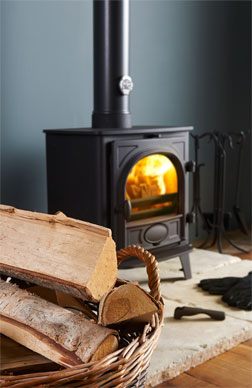
A common question, but first, what is the difference? Technically, there should be no difference, because well-seasoned logs should be properly dried to below 25% moisture content. But in reality, when one buys ‘seasoned firewood’, it often has a much higher reading. How many times have you heard your local supplier saying that the wood has been ‘down’ for over two years, so very dry, but when you burn it, the stove glass blackens and it struggles to burn? This is because the wood has not properly dried
So, what does ‘kiln drying’ provide? Well, first and foremost, it should provide consistency meaning that every log load you buy, whether it be in September, or February, should have a moisture content of 20% or below. Being consistently dry means it will light easily, burn cleanly and provide maximum heat output. By burning cleanly, this means the stove glass should not go black and consequently the burn up the chimney or flue will be clean and not cause excess soot or tarring. Until one tries kiln dried logs the difference cannot be truly appreciated and one of the most common responses is “I couldn’t believe how much more heat it gave off”.
 Some believe that by simply seasoning the wood, it is actually very difficult to achieve the same quality of log as kiln dried – probably true by the fact that generally people do not season the logs for long enough and are not drying them in the right way. Firstly, to properly season firewood, the wood must be cut into short log lengths, typically 25cm, and then split down the middle to increase the surface area and aid the drying process. Log diameter should be typically 5-15cm, and a range of sizes is perfect. The split logs need to be stacked under cover, with max airflow around the stack. How long the logs need to season will depend on the species. Ash, for example, might require 12-18 months whereas oak will probably need 3-4 years to get really dry and down to below 25% moisture – including the inside of the log.
Some believe that by simply seasoning the wood, it is actually very difficult to achieve the same quality of log as kiln dried – probably true by the fact that generally people do not season the logs for long enough and are not drying them in the right way. Firstly, to properly season firewood, the wood must be cut into short log lengths, typically 25cm, and then split down the middle to increase the surface area and aid the drying process. Log diameter should be typically 5-15cm, and a range of sizes is perfect. The split logs need to be stacked under cover, with max airflow around the stack. How long the logs need to season will depend on the species. Ash, for example, might require 12-18 months whereas oak will probably need 3-4 years to get really dry and down to below 25% moisture – including the inside of the log.
Kiln drying is a process of force drying which can be done within anything from 60 hours to a week, depending on the type of drying process. Drying wood this way virtually sucks the moisture out of the log, right from the centre. One thing you will always find with kiln dried logs, unlike really well seasoned logs, is that there will be more of a gradient in moisture content across the log. Kiln dried logs usually show 10-15% on the outside and 20-25% on the inside, with the overall average below 20%. In contrast, one would expect to see more consistent moisture content throughout the log when really well seasoned.
So, in summary unless you have tested that the seasoned logs are really dry, using a moisture meter, kiln dried logs are probably a convenient alternative. Just be aware that more and more people are supplying kiln dried logs, so try and make sure they carry the Woodsure and/or HETAS quality assurance certification for guaranteed quality.
cleanburn logs wood burning wood burning fires wood burning stoves
Sign up to our newsletter and receive the latest news and updates, including product launches, offers and promotions, exclusive giveaways and competitions, as well as seasonal tips and advice.
Subscribe Now!
Kiln dried logs are certainly a much more convenient alternative to natural seasoning. I’ve been using kiln dried logs for around 3 years now. I simply don’t have the time or space for seasoning logs anymore.
I wonder if kiln drying the logs, besides driving off the volatile water vapour, also drives off some useful flammable volatiles from the wood. Kiln dried logs are certainly more energy rich, by weight, but this costs more. Kiln dried logs burn very quickly, but have there been any comparative measured output kw/£ studies for kiln dried versus correctly seasoned logs?